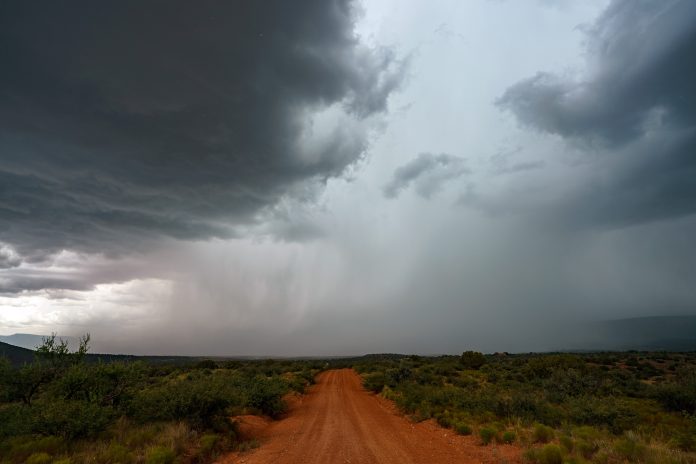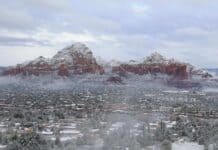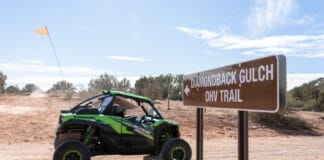
The good news is, climatologists don’t think these last two historically dry monsoons in a row represent the future of the Southwest monsoon.
The bad news is, researchers believe other parts of the year will get drier.
The 2020 Southwest monsoon is shaping up to be drier and hotter than last year’s “nonsoon,” which was the ninth driest and third hottest on record. A few isolated pockets in the Southwest got a decent soaking this summer, but region-wide — and locally — the monsoon’s been a bust.
It’s been so dry this year that University of Arizona climate scientist Dr. Mike Crimmins said he wanted a stronger term than “nonsoon” to differentiate 2020 from 2019.
Crimmins, and colleague Dr. Zack Guido, who together host the “Southwest Climate Podcast,” are dubbing the 2020 season a “failed monsoon.”
It’s not as catchy as “nonsoon,” but it gets the idea across.
Citing data from the WestWide Drought Tracker, Guido said that Arizona has had the driest — and hottest — combined July and August ever recorded. To date, Flagstaff is having its second-driest monsoon in modern records. Flagstaff’s driest was 2019.
After last year’s nonsoon and this year’s failed monsoon, some might be wondering, are we getting a vision of the future climate?
The short answer is, no.
“I don’t think this [monsoon] is a good analogue for future climate change,” Crimmins said on the Sept. 10 Southwest Climate Podcast. “The failure of the [2020] monsoon right now looks like natural variability.”
The monsoon is so variable year-to-year that it really could just be bad luck to have two very bad monsoons in a row. Most climate models predict that the basic mechanisms driving Arizona’s monsoon rains will stay intact in a warmer climate — at least in this century. Scientists can even envision scenarios where a warmer climate leads to more robust monsoons.
“In a warming world, one might expect … an earlier onset of the monsoon, because of the increased temperature gradient,” Guido said on the podcast. “I would think that a warming world would actually increase the chances of a more robust monsoon here in the Southwest, but … there is certainly no definitive answer.”
One aspect of the 2020 monsoon that Crimmins sees as potentially part of a new pattern is the record-breaking heat.
“The reason it was so hot is largely because the monsoon is failed, but I don’t think you can get to the level of temperatures that we saw during a failed monsoon without climate change. Because we’ve had past failed monsoons … but I think it’s impossible to say that climate change isn’t part of the temperature aspect of it,” Crimmins said on the show.
Crimmins and Guido agreed that the Southwest monsoon is a particularly difficult phenomenon to predict.
“There is still a lot uncertainty with summer season precipitation because the climate models really struggle to handle all of the small regional nuances that drive regional monsoon precipitation. Largely, they continue to predict little change with maybe some increasing intensity with thunderstorm events and maybe fewer storms overall within the season, but, again, confidence is low,” Crimmins told Sedona Red Rock News.
While climatologists don’t expect a big change to the Southwest’s summer monsoons, that does not hold true for other seasons.
In a current report on the modeled climate of the Southwest in the years between 2071 and 2100 by the Climate Assessment for the Southwest — a collaboration between the University of Arizona and New Mexico State University — researchers predict that the biggest changes in Northern Arizona’s precipitation will occur in the spring.
In the models, winter precipitation in Northern Arizona drops up to 10%, while spring precipitation drops over 30%. In the mid elevations of Arizona, where the Verde Valley is located, models project a 1% to 5% drop in soil moisture, “which is important for agriculture and ecosystems and has many societal implications,” the report stated.
According to Dr. Seth Munson of the U.S. Geographical Survey’s Southwest Biological Science Center, any change in Sedona’s annual pattern of rainfall — even if annual totals stayed the same — could change the composition of plant life in Northern Arizona’s landscape.
“Precipitation timing can be critical to support the growth of several species in Northern Arizona,” Munson said.
One reason that precipitation timing is so important is that many desert plants specialize in absorbing moisture at certain times of year, according to research by Dr. Susan Schwinning of the University of Arizona.
“Desert plants differ greatly in their uses of summer and winter water. Some deep-rooted woody plants do not take up any summer rain water,” Schwinning wrote. “Annuals and succulent perennials take up the most summer rain water. This diversity in water use suggests that most desert plants are not able to take up water wherever and whenever it becomes available.”
Consequently, changes to Sedona’s rain patterns could alter the plant life in the landscape, since some plants rely more on cool season moisture than summer moisture and vice versa.
Munson said that his research team in Flagstaff has actually observed changes in plant composition based on the timing of precipitation.
“We actually have a long-term experiment along an elevation gradient near the San Francisco Peaks addressing this very question,” Munson said. “In our experiment, we’re finding that cool season annuals [plants that can quickly colonize and finish their life-cycle in one year] are taking over where warm season perennial grasses have started to die-off, but eventually these cool season annuals could be replaced by cool season perennials.”





















